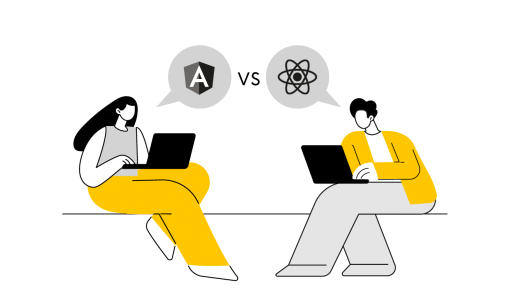There is a popular saying about front-end programming: "New day, new framework," indicating the dynamic changes in technology. According to Statista's 2022 data, the second most popular of the 25 software frameworks is React.js, used by 42.62% of developers, while another popular tool, Angular, is used by 20.39% of respondents.
Although attractive new technologies constantly emerge, the race toward trendy innovations slowly gives way to maturity and stability. This is especially true in large-scale projects.
Companies must stay on top of the latest technologies to maintain a competitive edge. However, issues such as compatibility, the presence of developers in the market for a given technology, or potential disruption to current operations are also important. Balancing the need for innovation with the stability of existing systems is a real challenge.
Why is caution important when it comes to technology selection?
To quote an experienced programmer sharing their insights on choosing technology for a project:
"At first, you are interested in everything that is the latest and shiny. Unfortunately, practice shows that it's easy to slip on something, and what works best is what has been proven by thousands of companies and corporations. That's why in large projects, I use more established technologies like React or Angular rather than frameworks that appeared 'yesterday'.” (Nikolaj Osadcij, Full-Stack Developer)
In this article, we will compare Angular and React in the context of large enterprise projects to consider which situation to use each. What impact do they have on productivity and end-user experience?
What is React?
React is a JavaScript library developed by Facebook and focused on building user interfaces. It is based on the ability to reuse components. React is often chosen for building web applications where the displayed data is regularly changed.
React has a large and active community, which has resulted in the development of various libraries, such as React Router (routing) and Redux (state management). The complete Next.js framework, which works with React.js to build interfaces, provides additional structure and helps optimize applications.
React's key features:
- Virtual DOM: This means that changes to the user interface are first made virtually, and React updates only the necessary parts of the actual DOM; thus, operations on the DOM tree are more efficient and result in faster page rendering.
- JSX: React uses JavaScript XML, simplifying the process of defining the structure and layout of components and rendering them.
- Component-based architecture: React applies modularity and components to build user interfaces. Each component individually manages its own state and passes data to subordinate components via properties (props).
- Unidirectional data flow: Data flows from master to slave components, helping maintain predictable state management.
- React Hooks: Hooks, added to React in version 16.8, allow function components to access state and other library properties.
Major companies using React include Instagram, Facebook, the New York Times, Netflix, Dropbox, WhatsApp, among others. These big brands have used the React.js library for specific purposes when developing additional or core product features.
Will React work well for large-scale projects?
React can be used in enterprise projects because it allows you to create scalable and high-performance applications. In addition, it is easy to learn, has a large and active developer community, and is supported by some of the biggest companies in the technology industry.
However, it can sometimes complicate teamwork because other developers must first learn the existing dependencies. In React, you have to put together the jigsaw of components yourself and know what additional libraries work together to make the application work without problems. It can be used to build the entire front-end of an application or website. Still, the project’s success will depend on the programmer's familiarity and experience with the technology.
Installing the Typescript library in React achieves greater scalability and better code quality. Although it takes effort to learn it, the long-term benefits it provides in terms of code quality, developer productivity, and collaboration outweigh the difficulties.
Now let's compare it with another popular front-end technology - Angular.
What is Angular?
Angular is a comprehensive framework for building web applications, developed and maintained primarily by Google. It allows developers to create dynamic, single-page applications (SPAs). Additionally, it provides a comprehensive set of tools and features to simplify the programming process.
Angular runs on a Model-View-Controller (MVC) architecture, in which components control views and handle data flow between model and view. If there are any conflicts between components, they can be quickly fixed in Angular. In React, on the other hand, it is not easy to quickly find a solution because there can be many combinations between components.
Other features of Angular include consistency and ease of maintenance in large projects.
80% of the projects where Angular is used are administration applications invisible to customers, such as CRM and ERP systems. Unlike React, where anyone can write the architecture as they see fit, in Angular, when a new person enters the project, they know immediately what to expect here; they know all the standards.
Each project has a similar structure and largely uses the same components. This means that each project is similar in structure, markup, and code. In general, the predictability of operations makes teamwork easier.
Angular offers a powerful set of features; its key features include:
- TypeScript: Angular is written in TypeScript, which enables optional static typing and class-based object-oriented programming, making it more scalable and easier to maintain.
- Directives: Angular provides a rich set of directives that allow you to extend HTML with custom attributes and behaviors. These are used to manipulate the DOM, add event detectors, control, or render.
- Templates: Angular uses HTML templates to define the structure and layout of the application's views.
- Dependency Injection: Angular has a built-in system for managing dependencies between different components. This means that the previously used bindings between components have been removed and replaced with a "manager" that creates dependency objects at the request of the class that needs them.
- Routing: the routing module allows you to define navigation paths and handle routing in the application and on the client side.
- RxJS extensions: Angular uses the reactive extension, a powerful library to handle asynchronous or callback-based code, such as handling HTTP requests and managing data streams.
Will Angular work well for complex projects?
Angular is a standalone front-end programming framework that can create forums, corporate portals, stock market platforms, real estate listings, etc.
The largest companies using Angular are:
- GitHub (forum)
- Google Information
- Forbes
- Deutsche Bank's development portal
Angular is a powerful tool used to create fully functional applications and websites.
Example of a project in Angular - portal for Deutsche Bahn
In a project for Leipzig-based N4, we are working on a portal to be used by Deutsche Bahn for procurement. Due to increased requirements, including IT security, Deutsche Bahn AG sought a more efficient, uniform, and modern solution. The application aims to simplify the bidding process to move away from manual work in Excel and make it easier to complete tasks. The application consists of six steps and can be used in three roles. We used Angular on the project’s front-end, which greatly reduced the number of errors.
The result is a solution that combines efficiency and excellent usability. Deutsche Bahn employees can now access the new tool via the intranet and quickly order services and resources from suppliers, selecting the most cost-effective contractor.
React or Angular in 2023? The choice depends on the scale and sophistication of the project
In summary, React is a lightweight and flexible library that excels at building interactive user interfaces. At the same time, Angular is a versatile framework that, while more difficult to learn, offers more built-in solutions, making it easier to continue working with your team. The choice between React and Angular depends on many factors, such as project requirements, your team's experience, and personal preferences.
If you want to learn more about applying the right tool to your project or are looking for dedicated developers, we encourage you to consult the front-end experts at VM Software. We will be happy to advise you on choosing the proper solutions. You can also look at our projects built for clients in Germany.



























